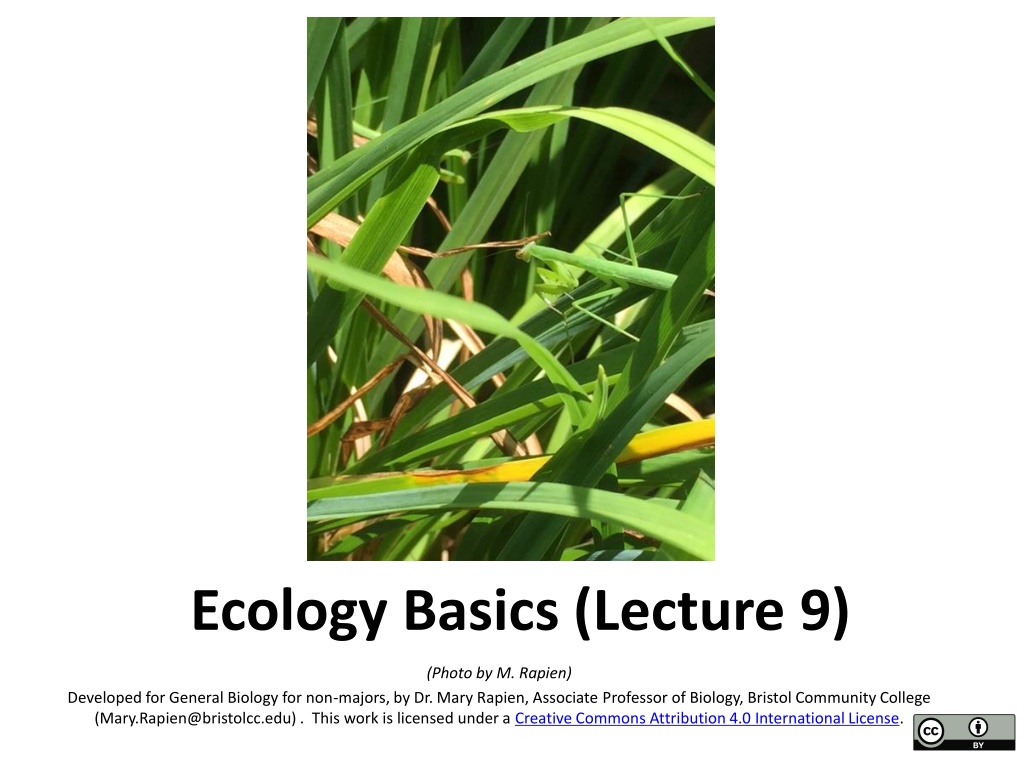Understanding Ecology: Ecosystems, Biodiversity, and Energy Flow
Explore the intricate world of ecology through topics such as ecosystems, biodiversity, energy flow, and nutrient cycling. Delve into the concept of niches, biodiversity levels, and the importance of energy flow and materials cycling in sustaining ecosystems. Learn about the nitrogen and carbon cycles, which are vital processes in maintaining the balance of elements within ecosystems.
Download Presentation

Please find below an Image/Link to download the presentation.
The content on the website is provided AS IS for your information and personal use only. It may not be sold, licensed, or shared on other websites without obtaining consent from the author. Download presentation by click this link. If you encounter any issues during the download, it is possible that the publisher has removed the file from their server.
E N D
Presentation Transcript
Ecology Basics (Lecture 9) (Photo by M. Rapien) Developed for General Biology for non-majors, by Dr. Mary Rapien, Associate Professor of Biology, Bristol Community College (Mary.Rapien@bristolcc.edu) . This work is licensed under a Creative Commons Attribution 4.0 International License. Creative Commons logo Creative Commons logo
Ecosystems An ecosystem includes all of the plants and animals, plus their physical surroundings (i.e. both biotic and abiotic factors). Each organism in a community occupies its own niche. Niche: the place occupied by a species in its ecosystem - where it lives, what it eats, its foraging route, the season of its activity, etc. More abstractly, a potential role within an ecosystem. Definitions from E.O. Wilson, 1992
Biodiversity The variety of organisms considered at all levels, from genetic variants belonging to the same species through arrays of species to arrays of genera, families, and still higher taxonomic levels; includes the variety of ecosystems, which comprise both the communities of organisms within particular habitats and the physical conditions under which they live. 2 components of species diversity: 1) Species Richness 2) Relative Abundance Approximately 1.8 million species have been described. Scientists estimate there are between 10 and 100 million species on Earth.
Energy Flow and Materials Cycling We can talk about ecosystems in terms of ENERGY FLOW and MATERIALS CYCLING Nutrients such as nitrogen, phosphorous and carbon cycle Energy flows through food webs predator/prey relationships
The Nitrogen Cycle Figure 20.12 OpenStax Concepts of Biology. Nitrogen enters the living world from the atmosphere through nitrogen-fixing bacteria. This nitrogen and nitrogenous waste from animals is then processed back into gaseous nitrogen by soil bacteria, which also supply terrestrial food webs with the organic nitrogen they need. (credit: modification of work by John M. Evans and Howard Perlman, USGS)
The Carbon Cycle Figure 20.11 OpenStax, Concepts of Biology. Carbon dioxide gas exists in the atmosphere and is dissolved in water. Photosynthesis converts carbon dioxide gas to organic carbon, and respiration cycles the organic carbon back into carbon dioxide gas. Long-term storage of organic carbon occurs when matter from living organisms is buried deep underground and becomes fossilized. Volcanic activity and, more recently, human emissions bring this stored carbon back into the carbon cycle. (credit: modification of work by John M. Evans and Howard Perlman, USGS)
Food Chains Figure 20.4 OpenStax Concepts of Biology. These are the trophic levels of a food chain in Lake Ontario at the United States Canada border. Energy and nutrients flow from photosynthetic green algae at the base to the top of the food chain: the Chinook salmon. (credit: modification of work by National Oceanic and Atmospheric Administration/NOAA)
Predator-prey Dynamics Figure 19.13 OpenStax Concepts of Biology. The cycling of snowshoe hare and lynx populations in Northern Ontario is an example of predator-prey dynamics.
Relative Energy Content in Trophic Levels Figure 20.5 OpenStax Concepts of Biology. The relative energy in trophic levels in a Silver Springs, Florida, ecosystem is shown. Each trophic level has less energy available, and usually, but not always, supports a smaller mass of organisms at the next level.
Food Webs Relationships between soil food web, plants, organic matter, and birds and mammals. Image courtesy of USDA Natural Resources Conservation Service. https://www.nrcs.usda.gov/wps/portal/nrcs/photogallery/soils/health/biology/gallery/?cid=1788&position=Promo
Keystone Species A keystone species is one that has a disproportionate effect on the ecosystem: i.e. a greater effect than its abundance would suggest. Often, this position is occupied by an apex predator. Sea Otter Sea Urchin Kelp
Symbiosis In addition to food web relationships, organisms can relate in other ways: Symbiosis Mutualism Commensalism Parasitism Competition
Competition in Paramecium spp. Figure 19.19 OpenStax Concepts of Biology
Commensalism Figure 19.20 OpenStax Concepts of Biology. The southern masked-weaver is starting to make a nest in a tree in Zambezi Valley, Zambia. This is an example of a commensal relationship, in which one species (the bird) benefits, while the other (the tree) neither benefits nor is harmed. (credit: Hanay /Wikimedia Commons)
Mutualism Figure 19.21 OpenStax Concepts of Biology (a) Termites form a mutualistic relationship with symbiotic protozoa in their guts, which allow both organisms to obtain energy from the cellulose the termite consumes. (b) Lichen is a fungus that has symbiotic photosynthetic algae living in close association. (credit a: modification of work by Scott Bauer, USDA; credit b: modification of work by Cory Zanker)
Parasitism Figure 19.22 OpenStax Concepts of Biology. This diagram shows the life cycle of the tapeworm, a human worm parasite. (credit: modification of work by CDC)
Invasive Species A species of plant or animal that is expanding its range to the detriment of the local ecosystem. Figure retrieved from Wikicommons, by user Anonymous Powered Asian Shore Crab
Funding This workforce product was funded by a TAACCCT grant awarded by the U.S. Department of Labor s Employment and Training Administration. The product was created by the grantee and does not necessarily reflect the official position of the U.S. Department of Labor. The U.S. Department of Labor makes no guarantees, warranties, or assurances of any kind, express or implied, with respect to such information, including any information on linked sites and including, but not limited to, accuracy of the information or its completeness, timeliness, usefulness, adequacy, continued availability, or ownership.























